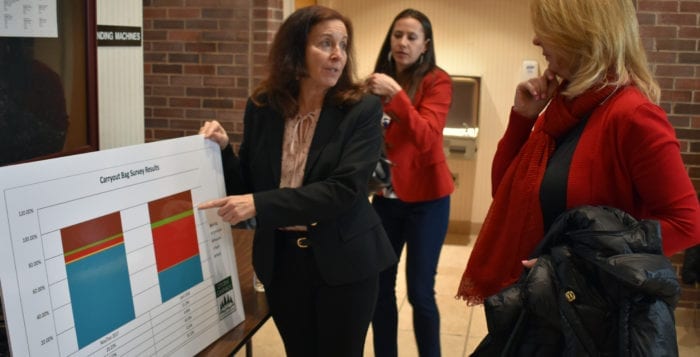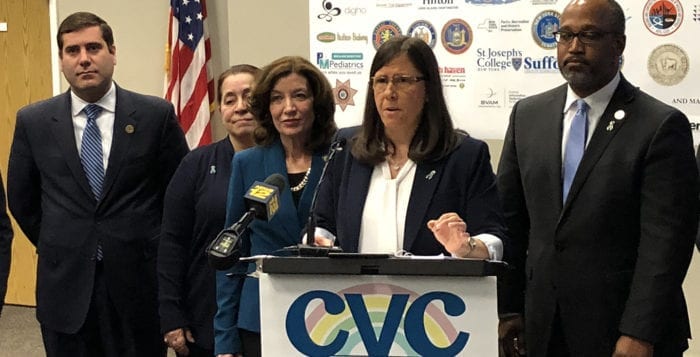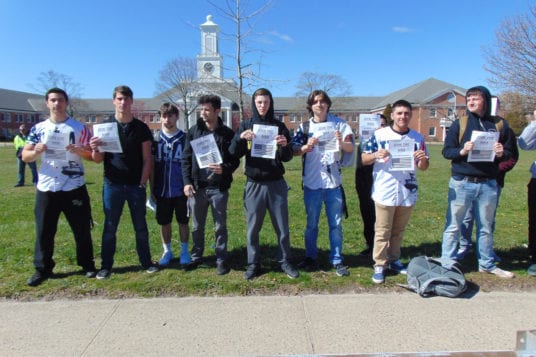After years of planning upper Port’s redevelopment to deal with blighted buildings, traffic and a lack of parking space, Port Jefferson Village officials are finally ready to say, “Don’t believe me, just watch.”
As part of the village’s revitalization efforts — a project dubbed “Uptown Funk” — village, Suffolk County and Brookhaven Town officials held a groundbreaking ceremony May 9 for a new parking lot in the space at the corner of Texaco Avenue and Linden Place. The lot should allow for another 74 parking spaces, largely for Long Island Rail Road commuters using the Port Jefferson train station.
“The village is thrilled to partner with the county, Empire State Development and the Long Island Rail Road on improvements in upper Port to enhance pedestrian connectivity and safety, revitalize blighted commercial properties, and promote safe living and economic growth,” Mayor Margot Garant said.
The revitalization of upper Port is part of the Connect LI project of Suffolk County Executive Steve Bellone (D). The plan behind the initiative is to use both existing and new public transportation options to connect people to commercial centers and main streets as in Port Jefferson.
“This is a model of what we need to be doing around the region,” Bellone said. “My administration is committed to providing funding to assist our towns and villages with these revitalization projects. The project we broke ground on today is a major step in continuing our efforts to make Suffolk County a great place to live, work and raise a family.”
Phase one of the project will cost $850,000 to be funded by grants from the county’s Jumpstart program and other financial contributions. Along with the parking lot the first phase of the project will improve sidewalks that lead to the train station from The Hills at Port Jefferson apartment complex.
Phase two of the project will include a renovation of the north, east and south LIRR parking lots with new pavement, lighting and plaza entryway.
Phase three will create “Station Street,” a new one-way road that will provide access to the new renovated parking lots. Garant said the road should also reduce congestion on Main Street and allow for smoother access into the train station parking lots.
Part of the hope for the project is that students coming from Stony Brook University and other commuters will help create interest in the area, which in turn should incentivize businesses to invest in upper Port and remedy the blighted property seen on Main Street, according to Garant.
“We want feet on the street,” Garant said.
Last year Nicole Christian, a consultant at law firm HB Solutions and grant writer for the village, helped apply for several grants for the Uptown Funk project. Last year Port Jefferson Village was awarded $250,000 in Jumpstart money to start plans on the project and the village also applied for a grant from the Empire State Development Corporation, a state entity, for $500,000.
“Empire State Development is excited to support this roadway realignment that will foster this transit-oriented development and revitalize this community to create a true linkage from upper Port Jefferson to the waterfront,” Howard Zemsky, ESD president, said in an email.
Part of the purpose of the new parking lot is also to help facilitate foot traffic from The Hills at Port Jefferson to the train station across the street. “All of the apartments in two separate buildings, which were completed in 2016, have already been rented out and there is already a long wait list to get in,” said Tony Gitto of The Gitto Group, the real estate development company behind development of the apartment complex, during the event.
The Town of Brookhaven and Port Jefferson Village worked with Gitto and his company to create the two-building complex. To incentivize the creation of the apartment complex, Brookhaven Industrial Development Agency, an arm of municipalities dedicated to funding projects to stimulate job creation and economic growth, gave Gitto and his company sales tax exemptions on construction items, a mortgage tax exemption and a 10-year property tax abatement.
Gitto said that they provided money toward the funding of the new parking lot.
“They hired the contractors and we made a financial contribution,” Gitto said.
This post was updated May 15.
























